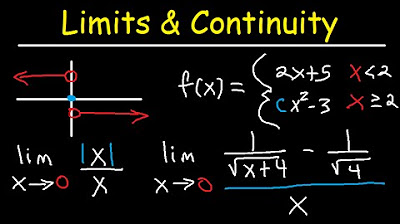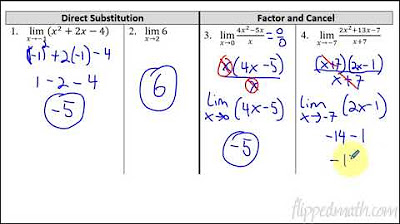How to Find Any Limit: Part 2 (NancyPi)
TLDRIn this educational video, Nancy explains how to find limits at finite values, focusing on unique cases involving square roots, trigonometric functions, and absolute values. She demonstrates techniques such as multiplying by the conjugate for square roots, using the sine over theta limit property for trigonometric expressions, and employing piecewise definitions for absolute values. Nancy's approach emphasizes understanding indeterminate forms and applying specific properties to simplify expressions and determine limits, even in cases of discontinuity.
Takeaways
- 📚 The video is a tutorial on finding limits at finite values, not at infinity, covering unique types of limits that may be less common but still useful.
- 🔍 It introduces specific types of limit problems, such as those involving square roots, sine functions, and absolute values, and provides strategies to solve them.
- 📐 For limits with square roots, if direct substitution results in an indeterminate form like 0/0, multiplying by the conjugate can help simplify the expression and find the limit.
- 🤹♂️ The conjugate is a term flipped in sign used to rationalize square roots, and it's applied by multiplying both the numerator and the denominator by this conjugate.
- 🧩 After rationalizing, terms may cancel out, simplifying the expression and allowing for a direct substitution to find the limit.
- 🌐 A special limit property is highlighted: the limit of (sin theta)/theta as theta approaches 0 equals 1, which is useful for certain trigonometric limit problems.
- 🔄 It's important to distinguish between this property and the limit of (sin theta)/theta as theta approaches infinity, which equals 0.
- 📉 For limits involving the sine function in a form like (sin 2x)/x, manipulating the expression to match the (sin x)/x form allows the use of the special limit property.
- 📌 The video provides examples of how to rearrange and balance expressions to fit the known limit properties, such as multiplying by 1 in the form of 2/2 to maintain the limit's value.
- 🚫 When dealing with absolute value in limits, direct substitution often leads to an indeterminate form, necessitating the use of the piecewise definition of absolute value.
- 🔍 The piecewise definition allows for the expression to be split into two cases based on the sign of the quantity inside the absolute value, which is crucial for determining one-sided limits.
- 📍 One-sided limits must agree for the overall limit to exist; if they differ, the limit does not exist (DNE), indicating a point of discontinuity in the function.
Q & A
What is the main topic of the video script?
-The main topic of the video script is how to find the limit of a function at a finite value, covering specific types of expressions such as those with square roots, sine functions, and absolute values.
What is the first step recommended when trying to find the limit of an expression with a square root in the numerator or denominator?
-The first step recommended is to plug in the value at which the limit is being sought, even if it results in an indeterminate form like zero over zero.
What is the conjugate and how is it used in simplifying expressions with square roots?
-The conjugate is a term formed by changing the sign of the second part of a two-term expression. It is used by multiplying both the numerator and the denominator of the expression by the conjugate to simplify the expression, which can help in finding the limit.
What is the special property of (sin theta)/theta as theta approaches 0?
-The special property is that the limit of (sin theta)/theta as theta approaches 0 equals 1.
How can you manipulate an expression like (sin 2x)/x to use the special property of (sin theta)/theta?
-You can manipulate the expression by ensuring that the argument of the sine function matches the denominator, for example, by rewriting (sin 2x)/x as (sin 2x)/(2x) to apply the property.
What is the difference between the limit of (sin theta)/theta as theta approaches 0 and as theta approaches infinity?
-The limit of (sin theta)/theta as theta approaches 0 is 1, whereas as theta approaches infinity, the limit is 0.
What is the piecewise definition of the absolute value function?
-The piecewise definition of the absolute value function states that if x is positive or zero, the absolute value of x is x, and if x is negative, the absolute value of x is -x.
Why is it necessary to find both the right-sided and left-sided limits when dealing with absolute value expressions?
-It is necessary to find both the right-sided and left-sided limits to determine if they agree, as this agreement is required for the overall limit to exist at the given point.
What does it mean if the right-sided and left-sided limits of an absolute value expression do not match?
-If the right-sided and left-sided limits do not match, it means that the overall limit does not exist at the given point, indicating a discontinuity at that point.
How can you identify a discontinuity in a function based on the limits?
-A discontinuity can be identified if the right-sided and left-sided limits of a function at a certain point do not agree, indicating a sudden jump or change in the function's value at that point.
Outlines
📚 Introduction to Unique Limit Finding Techniques
Nancy introduces Part Two of 'How to Find the Limit' at a finite value, focusing on unique types of limits that don't involve infinity. She outlines the types to be covered, including limits with square roots, sin x/x forms, and absolute values. Nancy emphasizes that mastering these, along with techniques from the first video, will make the viewer adept at finding finite limits. She begins with an example involving a square root in a fraction, leading to an indeterminate form, and suggests alternative methods when direct substitution fails.
🔍 Dealing with Square Roots and Conjugates in Limits
The paragraph explains how to handle limits with square roots in the numerator or denominator by using the conjugate to rationalize the expression. Nancy demonstrates this with an example, showing the process of multiplying by the conjugate and simplifying the expression using FOIL. This technique eliminates the problematic term that causes a zero in the denominator, allowing for the successful calculation of the limit after simplification.
📉 Utilizing Trigonometric Properties for Limit Calculations
Nancy discusses the use of trigonometric properties to find limits, particularly focusing on the form (sin x)/x, which approaches 1 as x approaches 0. She warns against confusing this with the property for limits as x approaches infinity. The paragraph includes examples of manipulating expressions to fit the known property, such as adjusting (sin 2x)/x to match the form (sin x)/x by introducing a 2 in both the numerator and denominator, resulting in a limit of 2.
🔢 Absolute Value Limits and Piecewise Functions
This section addresses how to find limits involving absolute values, which cannot be directly substituted due to resulting in an indeterminate form. Nancy introduces the piecewise definition of the absolute value function and demonstrates how to apply it to find the limit as x approaches a specific value. The process involves breaking down the absolute value into two cases based on the sign of the expression inside and then calculating both the right-sided and left-sided limits to determine if the overall limit exists.
🚫 Understanding Discontinuities and Non-Existent Limits
The final paragraph explains the concept of non-existent limits, particularly at points of discontinuity. Nancy illustrates this with an example involving an absolute value expression, showing that if the right-sided and left-sided limits do not match, the overall limit does not exist. She uses the piecewise definition to find that the right-sided limit is 1 and the left-sided limit is -1, indicating a discontinuity at x=2 and concluding that the overall limit does not exist (DNE).
Mindmap
Keywords
💡Limit
💡Indeterminate Form
💡Square Root
💡Conjugate
💡Rationalizing the Numerator
💡Trigonometric Identity
💡Absolute Value
💡Piecewise Function
💡One-Sided Limits
💡Discontinuity
💡Tangent
Highlights
Introduction to Part Two of 'How to Find the Limit' at a finite value, covering unique types of limits that are useful but might not be commonly known.
Explanation of when to use video links or description to skip to specific types of limit problems.
Discussion on handling square roots in the numerator or denominator of a fraction by using the conjugate to rationalize the expression.
Clarification that plugging in the value does not always work, especially when it results in an indeterminate form like zero over zero.
Demonstration of the FOIL method to simplify expressions after multiplying by the conjugate.
Illustration of how to cancel out problematic terms in the denominator to find the limit.
Final simplification leading to the limit value of 1/6 for a given square root expression.
Introduction to the limit property of (sin theta)/theta as theta approaches 0, equaling 1.
Warning against confusing the limit property of (sin theta)/theta as theta approaches infinity, which equals 0.
Technique to manipulate expressions to fit the (sin x)/x limit property by adjusting the argument of the sine function.
Example of how to adjust the denominator to match the sine argument to utilize the limit property.
Explanation of how to handle limits involving absolute values by using the piecewise definition of the absolute value function.
Process of finding one-sided limits for absolute value expressions and the importance of matching left and right limits.
Example of a limit problem with absolute value where the left and right limits do not match, resulting in a non-existent limit.
Discussion on the concept of discontinuity and its relation to non-existent limits at points of abrupt change in a function.
Encouragement to like or subscribe to the video for more help on understanding limits at finite values.
Transcripts
Browse More Related Video

How to Find Any Limit (NancyPi)

AP Calculus AB: Evaluating Transcendental Limits

One Sided Limits, Graphs, Continuity, Infinity, Absolute Value, Squeeze Thereom - Calculus Review

Limits and Absolute Value

Calculus AB/BC – 1.6 Determining Limits Using Algebraic Manipulation

Limit examples w/ brain malfunction on first prob (part 4) | Differential Calculus | Khan Academy
5.0 / 5 (0 votes)
Thanks for rating: